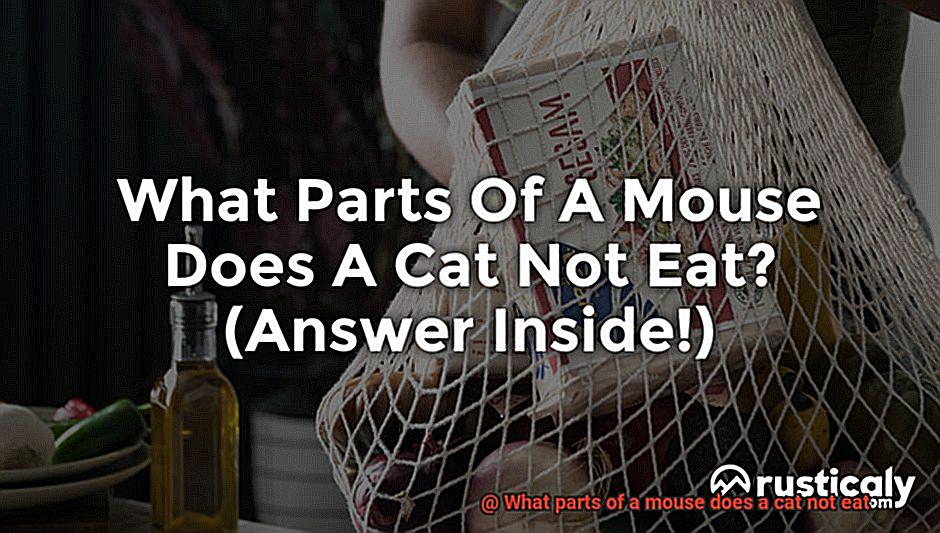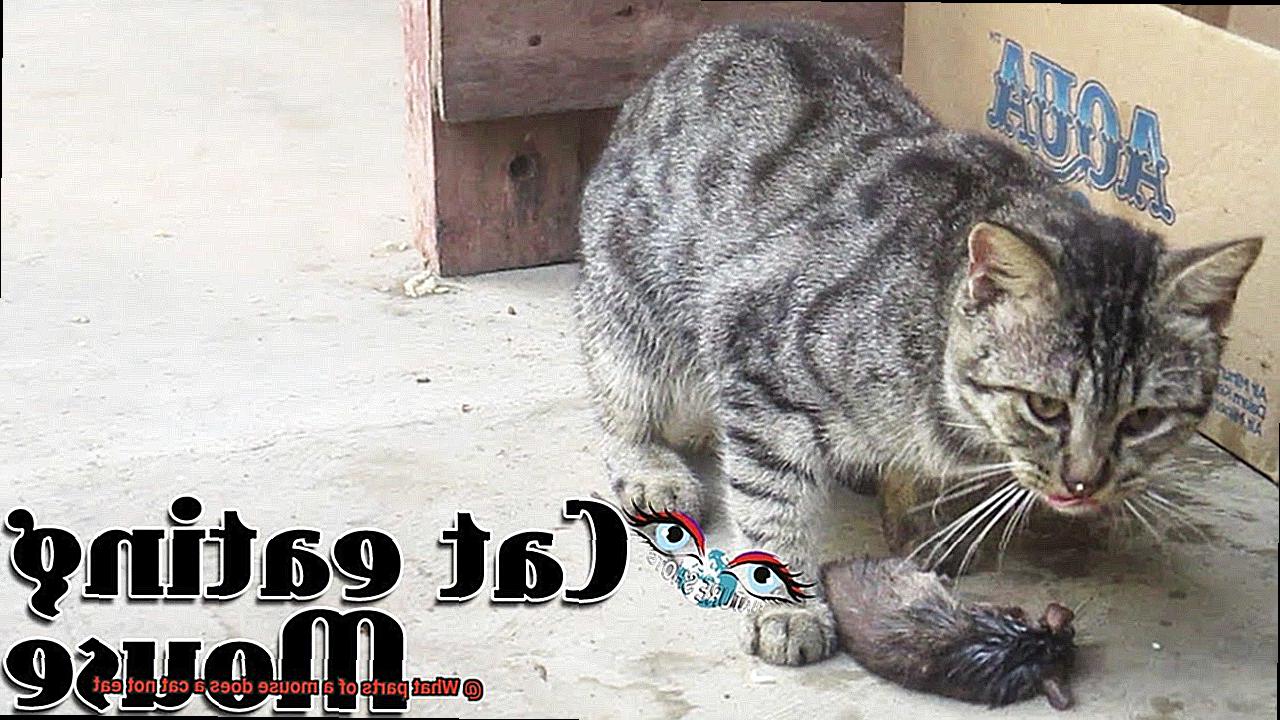Cats are natural born hunters, and their love for chasing and killing prey is well known. Mice are one of their favorite targets, but have you ever wondered if cats eat every part of a mouse? It’s a curious question with an interesting answer.
Although cats are not picky eaters, some parts of the mouse are not as appetizing to them. The skin, fur, and tail of a mouse tend to be avoided due to their texture and taste. However, they will happily devour the organs, muscles, and bones which are packed with nutrients and protein.
What about the head and eyes? Well, it turns out that cats might leave them behind too. While these body parts are not harmful to cats, they may not be as appealing as other parts of the mouse. Moreover, they don’t offer as much protein compared to other portions of the body.
Interestingly enough, cats also tend to avoid eating the gallbladder of a mouse. This is because it contains bile which has a bitter taste that can upset their stomachs.
So next time your feline friend presents you with a gift in the form of a mouse; take a closer look at what’s left behind. Despite being skilled predators with an impressive reputation for hunting prowess; cats still have their likes and dislikes when it comes to food.
Cats as Natural Predators and Hunters
Cats have been domesticated for thousands of years, but their hunting instincts have remained intact. These natural predators are highly skilled hunters that can easily catch their prey with their sharp teeth and claws. However, what sets cats apart from other animals is their ability to use their senses to locate and capture prey.
Cats rely on their sharp eyesight, sensitive hearing, and strong sense of smell to track down small prey such as mice, rats, and birds. Once they spot their prey, they become stealthy hunters, stalking it quietly until they are close enough to pounce. With lightning-fast reflexes, cats often kill their prey instantly by biting its neck or head.
But have you ever wondered why cats don’t eat all parts of their prey? The reason is simple: some parts of the mouse are indigestible and can cause digestive issues or even harm the cat. For instance, the bones in the head and tail of a mouse can puncture a cat’s intestines or cause blockages in its system. Similarly, internal organs such as the liver, kidneys, and intestines may contain harmful bacteria or toxins that could make your cat sick.
As responsible pet owners, it’s vital to monitor your cat’s behavior and diet carefully. If your cat shows any signs of illness or discomfort after eating a mouse, seek veterinary care immediately. It’s also essential to keep in mind that while cats may enjoy hunting and catching prey, it’s crucial to ensure they are not consuming any parts that could potentially harm them.
The Head: Not Safe for Cats to Eat
However, not all parts of their catch are safe for them to consume. One part that is particularly dangerous for cats to eat is the head of a mouse.
Although it may seem like a harmless meal for your kitty, the head of a mouse can pose serious health risks. The bones in the head can easily get lodged in your cat’s throat or digestive tract, leading to choking or other life-threatening health issues.
Furthermore, the head of a mouse can be contaminated by harmful bacteria and parasites that can make your cat seriously ill. These include viruses like hantavirus and infections like salmonella. Even if your cat manages to digest the head without any immediate issues, they may still be at risk of contracting a disease or infection from the mouse.
It’s important to remember that while cats may instinctively want to eat every part of the mouse they catch, it’s up to us as responsible pet owners to keep them safe and healthy. If you suspect your cat has eaten the head of a mouse or any other potentially harmful part, it’s crucial to monitor them closely for any signs of illness or discomfort.

The Tail: Not Safe for Cats to Eat
While cats are natural hunters and may enjoy chasing mice, it is crucial to be aware of the potential risks of consuming certain parts of their prey. In this section, we will explore why it is not safe for cats to eat the tail of a mouse.
Firstly, the tail of a mouse contains numerous small and delicate bones that can quickly become lodged in a cat’s throat or digestive system. This can cause serious health problems like choking or blockages, leading to discomfort and pain for your beloved pet. That’s why it’s essential to keep a close eye on your cat when they’re hunting and ensure they don’t consume any parts that could be harmful to them.
Secondly, the tail of a mouse can harbor parasites and bacteria that can be dangerous for cats if ingested. Mice often carry diseases and parasites like tapeworms, roundworms, and even hantavirus, which can be fatal in some cases. By eating the tail of a mouse, your cat can expose themselves to these harmful pathogens, leading to severe health issues.
It is crucial to monitor your cat’s hunting activities and ensure that they do not consume any part of the prey that could be harmful to them. In addition to avoiding the tail, it is also recommended that cats do not eat the head or internal organs of a mouse or any other prey animal.
Internal Organs: Not Safe for Cats to Eat
While it may seem like a natural thing for cats to do, it’s essential to understand the potential risks involved.
Internal organs such as the liver, kidneys, pancreas, and intestines contain high amounts of vitamin A and other nutrients that are essential for a cat’s diet. However, they also contain harmful substances like toxins and bacteria that can make cats sick or even lead to death.
Furthermore, digesting internal organs requires more time and effort from a cat’s digestive system than digesting muscle meat. This can cause digestive issues such as vomiting or diarrhea, which can be uncomfortable for your feline friend.
Therefore, it is highly recommended that cat owners avoid feeding their cats raw or cooked internal organs of mice or any other prey. Instead, providing a balanced diet that meets their nutritional needs is crucial. You can achieve this by feeding them high-quality commercial cat food that contains all the necessary nutrients in the right proportions.
It’s important to keep in mind that providing your cat with a balanced diet not only keeps them healthy but also happy. Fresh water and occasional treats can also help keep your feline friend content.
Instinctive Knowledge of What Parts of a Mouse not to Eat
The sight of a cat hunting and devouring a mouse is both impressive and fascinating. But have you ever wondered why cats don’t eat all parts of their prey? Well, wonder no more. It turns out that cats have an instinctive knowledge of what parts of a mouse not to eat, and it’s not just because they’re picky eaters.
Cats are natural-born hunters, and their skills have been honed over thousands of years of evolution. They know what parts of their prey are safe to consume and which ones are not. For instance, cats will avoid eating the fur and skin of a mouse because it’s not palatable to them. Similarly, they won’t eat the bones and teeth because they’re hard to digest and can cause digestive issues like constipation or blockages.
But it’s not just about taste preferences and digestive limitations. Cats also avoid certain parts because of their natural instincts. For example, they won’t eat the head of a mouse because it contains vital organs like the brain and eyes, which are not only hard to digest but also potentially dangerous if consumed.
As pet owners, we need to be mindful of the dietary needs of our feline friends. While it may be tempting to offer them internal organs of mice as a treat or for entertainment purposes, it’s crucial to remember that these can contain toxins and bacteria that can make cats sick or even lead to death.
Therefore, as responsible pet owners, we should provide our cats with a balanced and nutritious diet that meets their nutritional needs in the right proportions. We should also ensure they always have access to fresh water and occasional treats while avoiding feeding them any harmful foods.
Responsible Pet Ownership

If you have a cat that loves to hunt mice, it’s important to know which parts of the prey could potentially harm them.
Firstly, cats should avoid eating the internal organs of a mouse, such as the liver and kidneys. These organs can be packed with toxins and bacteria that could cause serious health issues for your cat. The bones of a mouse are also dangerous for cats to consume as they can splinter and cause internal damage.
Fur is another part of a mouse that cats should avoid eating in large amounts. While some cats may love to play with and chew on the fur of their prey, consuming too much fur can lead to digestive problems like hairballs.
As responsible pet owners, we need to keep an eye on our cat’s hunting habits and make sure they’re not consuming any harmful parts of their prey. Providing safe toys and activities for them to satisfy their natural hunting instincts can help prevent them from eating parts of mice or other small animals.
I5Zw49Nwi0w” >
Conclusion
In conclusion, cats are natural hunters and have an innate understanding of what parts of a mouse they should avoid. Although they may enjoy the thrill of hunting and catching mice, they tend to steer clear of certain parts due to their texture, taste, or potential harm. Cats will happily devour the organs, muscles, and bones of a mouse as they are rich in nutrients and protein. However, they typically avoid the skin, fur, tail, head, eyes, and gallbladder.
As responsible pet owners, it is crucial to monitor our cat’s behavior and diet closely. We need to ensure that they do not ingest any parts that could potentially harm them such as the internal organs or bones in the head or tail of a mouse. Providing our cats with a well-balanced and nutritious diet that meets their nutritional needs is essential for their overall health and happiness.
While observing our feline friends hunt can be intriguing and impressive, we must remember that they possess an instinctive knowledge of what parts of their prey are safe to eat. As pet owners, it is our duty to keep them safe from harm by offering appropriate toys and activities that satisfy their natural hunting instincts without endangering them.

